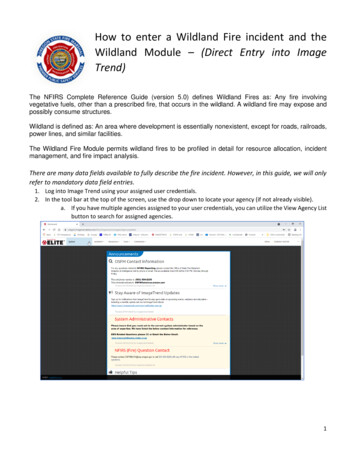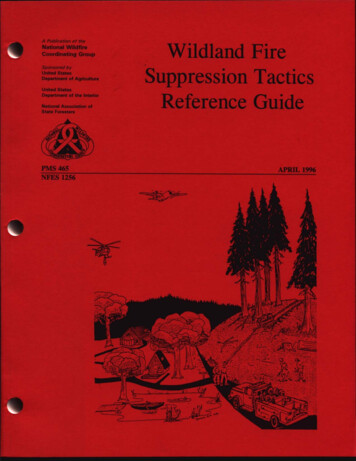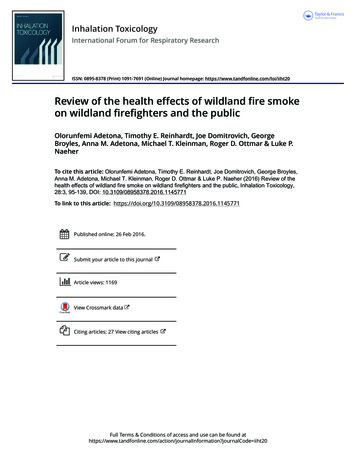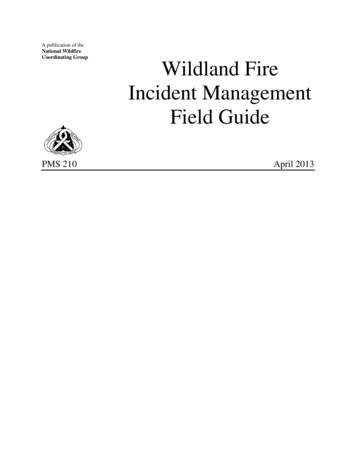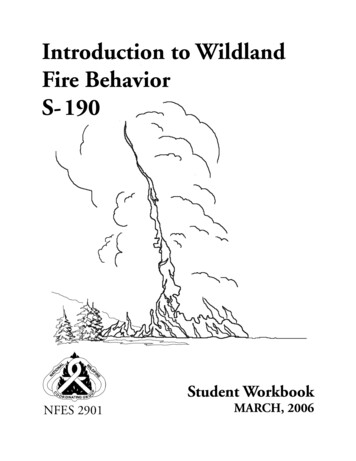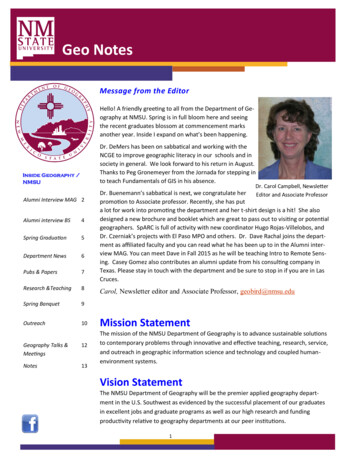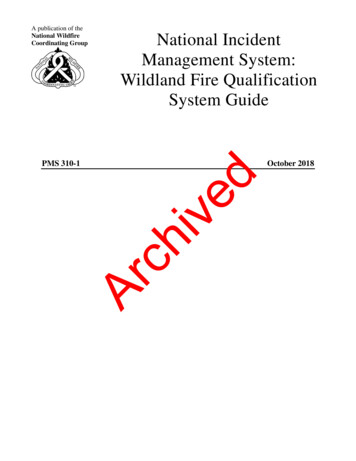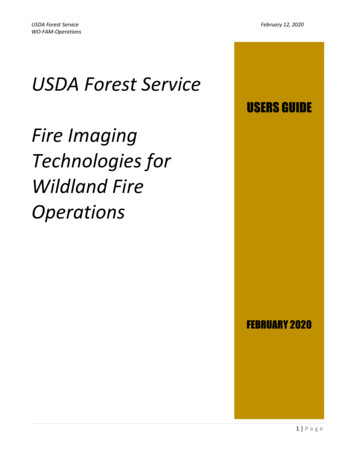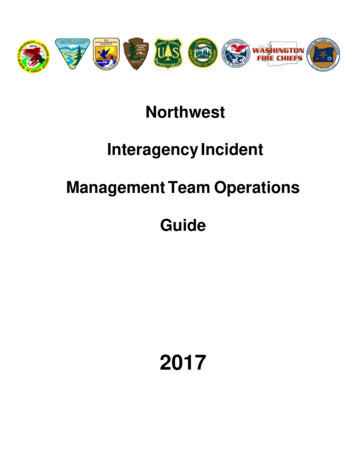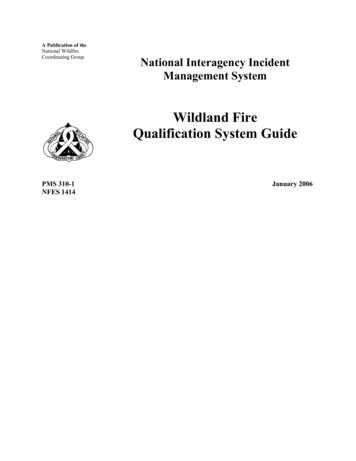
Transcription
A Publication of theNational WildfireCoordinating GroupNational Interagency IncidentManagement SystemWildland FireQualification System GuidePMS 310-1NFES 1414January 2006
EDIVARCH(This page intentionally left blank)2PMS 310-1 January 2006
National InteragencyIncident Management SystemWildland FireQualification System GuidePMS 310-1Prepared byNational Wildfire Coordinating GroupIncident Operations Standards Working TeamJanuary 2006This document can be accessed at http://www.nwcg.govAdditional copies of this publication may be ordered from: National Interagency Fire Center (NIFC), Attention:Great Basin Cache Supply Office, 3833 S. Development Ave., Boise, Idaho 83705. Order NFES# 14143PMS 310-1 January 2006
Contents2006 Revision SummaryBackground . . . . . . . . . . . . . . . . . . . . . . . . . . . . . . . . . . . . . . . . . . . . . . . . . . . . . . . . . . . . 6Objectives . . . . . . . . . . . . . . . . . . . . . . . . . . . . . . . . . . . . . . . . . . . . . . . . . . . . . . . . . . . . . 6Major Changes . . . . . . . . . . . . . . . . . . . . . . . . . . . . . . . . . . . . . . . . . . . . . . . . . . . . . . . . 6-8IntroductionHow the 310-1 Relates to the National Response Plan (NRP) . . . . . . . . . . . . . . . . . . . . . 9Description of the Performance Based System . . . . . . . . . . . . . . . . . . . . . . . . . . . . . . . . . . . . 10Certification and Recertification . . . . . . . . . . . . . . . . . . . . . . . . . . . . . . . . . . . . . . . . . . . . . . . 11Position QualificationsRequired Training . . . . . . . . . . . . . . . . . . . . . . . . . . . . . . . . . . . . . . . . . . . . . . . . . . . . . . 12Recurrent Training . . . . . . . . . . . . . . . . . . . . . . . . . . . . . . . . . . . . . . . . . . . . . . . . . . . . . . 12Annual Fireline Safety Refresher (RT-130) Training . . . . . . . . . . . . . . . . . . . . . 12Required Experience . . . . . . . . . . . . . . . . . . . . . . . . . . . . . . . . . . . . . . . . . . . . . . . . . . . . .12Physical Fitness Levels . . . . . . . . . . . . . . . . . . . . . . . . . . . . . . . . . . . . . . . . . . . . . . . . . . .13Currency Requirements . . . . . . . . . . . . . . . . . . . . . . . . . . . . . . . . . . . . . . . . . . . . . . . . . .14Other Training Which Supports Development of Knowledge and Skills . . . . . . . . . . . . 14National Wildfire Coordinating Group (NWCG) Compliance with National IncidentManagement System (NIMS) Training . . . . . . . . . . . . . . . . . . . . . . . . . . . . . . . . 15Incident Complexity (Wildfire and Wildland Fire Use) . . . . . . . . . . . . . . . . . . . . . . . . . . . . . . .15Prescribed Fire Complexity . . . . . . . . . . . . . . . . . . . . . . . . . . . . . . . . . . . . . . . . . . . . . . . . . . . .15Position CategoriesCriteria for Position Consideration in the 310-1 . . . . . . . . . . . . . . . . . . . . . . . . . . . . . . . 16Technical Specialists . . . . . . . . . . . . . . . . . . . . . . . . . . . . . . . . . . . . . . . . . . . . . . . . . . . . 16Incident Command System (ICS) Positions . . . . . . . . . . . . . . . . . . . . . . . . . . . . . . . . 17-18Wildland Fire Positions . . . . . . . . . . . . . . . . . . . . . . . . . . . . . . . . . . . . . . . . . . . . . . . 18-19Incident Support Positions . . . . . . . . . . . . . . . . . . . . . . . . . . . . . . . . . . . . . . . . . . . . . . . . 19Associated Activities Positions . . . . . . . . . . . . . . . . . . . . . . . . . . . . . . . . . . . . . . . . . . . . 19Nationally Mobilized Area Command,and Type 1 and Type 2 Incident Management Teams . . . . . . . . . . . . . . . . . . . . . . . . . . . . . 204PMS 310-1 January 2006
Position Task Book (PTB) Design and UsePosition Task Book Initiation . . . . . . . . . . . . . . . . . . . . . . . . . . . . . . . . . . . . . . . . . . . . . 21Position Task Book Completion Timeframes . . . . . . . . . . . . . . . . . . . . . . . . . . . . . . . . . 21Position Task Book Sections . . . . . . . . . . . . . . . . . . . . . . . . . . . . . . . . . . . . . . . . . . . . . 22Cover . . . . . . . . . . . . . . . . . . . . . . . . . . . . . . . . . . . . . . . . . . . . . . . . . . . . . . . . . . 22Verification/Certification of Completed Task Book . . . . . . . . . . . . . . . . . . . . . . 22Qualification Record . . . . . . . . . . . . . . . . . . . . . . . . . . . . . . . . . . . . . . . . . . . . 22-23Evaluation Record . . . . . . . . . . . . . . . . . . . . . . . . . . . . . . . . . . . . . . . . . . . . . . . . 23Position Task Book Responsibilities . . . . . . . . . . . . . . . . . . . . . . . . . . . . . . . . . . . . . . . . 24The Home Unit/Certifying Official . . . . . . . . . . . . . . . . . . . . . . . . . . . . . . . . 24-25The Trainee . . . . . . . . . . . . . . . . . . . . . . . . . . . . . . . . . . . . . . . . . . . . . . . . . . . . . 25The Evaluator . . . . . . . . . . . . . . . . . . . . . . . . . . . . . . . . . . . . . . . . . . . . . . . . . . . . 26The Trainer/Coach . . . . . . . . . . . . . . . . . . . . . . . . . . . . . . . . . . . . . . . . . . . . . . . . 27The Training Specialist . . . . . . . . . . . . . . . . . . . . . . . . . . . . . . . . . . . . . . . . . . . . 28Position Task Book Special Considerations and Exceptions . . . . . . . . . . . . . . . . . . . . . . 29Positions without NWCG Position Task Books . . . . . . . . . . . . . . . . . . . . . . . . . 29Positions with the Same Position Task Bookfor Type 1 and Type 2 Complexity Levels . . . . . . . . . . . . . . . . . . . . . . . 29Positions with Combined Position Task Books . . . . . . . . . . . . . . . . . . . . . . . . . 30Review and Update Process for the 310-1 and Position Task Books . . . . . . . . . . . . . . . . . . 31Position Qualification SectionsCommand and General Staff . . . . . . . . . . . . . . . . . . . . . . . . . . . . . . . . . . . . . . . . . . . 33-54Operations . . . . . . . . . . . . . . . . . . . . . . . . . . . . . . . . . . . . . . . . . . . . . . . . . . . . . . . . . 55-75Air Operations . . . . . . . . . . . . . . . . . . . . . . . . . . . . . . . . . . . . . . . . . . . . . . . . . . . . . . 76-91Planning . . . . . . . . . . . . . . . . . . . . . . . . . . . . . . . . . . . . . . . . . . . . . . . . . . . . . . . . . . 92-108Logistics . . . . . . . . . . . . . . . . . . . . . . . . . . . . . . . . . . . . . . . . . . . . . . . . . . . . . . . . . 109-128Finance/Administration . . . . . . . . . . . . . . . . . . . . . . . . . . . . . . . . . . . . . . . . . . . . . 129-142Dispatch . . . . . . . . . . . . . . . . . . . . . . . . . . . . . . . . . . . . . . . . . . . . . . . . . . . . . . . . . 143-149Prevention & Investigation. . . . . . . . . . . . . . . . . . . . . . . . . . . . . . . . . . . . . . . . . . . 150-153Qualification Flow Charts . . . . . . . . . . . . . . . . . . . . . . . . . . . . . . . . . . . . . . . . . . . . . . . . . . . . 155Area Command . . . . . . . . . . . . . . . . . . . . . . . . . . . . . . . . . . . . . . . . . . . . . . . . . . . . . . . 156Command and General Staff . . . . . . . . . . . . . . . . . . . . . . . . . . . . . . . . . . . . . . . . . . . . . 157Operations . . . . . . . . . . . . . . . . . . . . . . . . . . . . . . . . . . . . . . . . . . . . . . . . . . . . . . . . . . . 158Air Operations . . . . . . . . . . . . . . . . . . . . . . . . . . . . . . . . . . . . . . . . . . . . . . . . . . . . . . . . 159Planning . . . . . . . . . . . . . . . . . . . . . . . . . . . . . . . . . . . . . . . . . . . . . . . . . . . . . . . . . . . . . 160Logistics . . . . . . . . . . . . . . . . . . . . . . . . . . . . . . . . . . . . . . . . . . . . . . . . . . . . . . . . . . . . . 161Finance/Administration . . . . . . . . . . . . . . . . . . . . . . . . . . . . . . . . . . . . . . . . . . . . . . . . . 162Dispatch . . . . . . . . . . . . . . . . . . . . . . . . . . . . . . . . . . . . . . . . . . . . . . . . . . . . . . . . . . . . . 163Prevention & Investigation . . . . . . . . . . . . . . . . . . . . . . . . . . . . . . . . . . . . . . . . . . . . . . 1645PMS 310-1 January 2006
2006 REVISION SUMMARYBackgroundThe following summarizes the January 2006 revision of the Wildland Fire Qualification SystemGuide (PMS 310-1) and identifies major changes since the January 2000 version. This revisioninvolved field review, solicitations of comments from state, tribal, and federal agencies under theNational Wildfire Coordinating Group (NWCG), and the combined efforts of NWCG WorkingTeams.ObjectivesEstablish minimum interagency training and qualification standards for national mobilization towildland fire assignments.Maintain the foundation of the performance based qualification system established in previousversions of this guide.Strengthen the training and qualifications standards for positions related to responder health andfireline safety identified in agency reviews, as a result of national studies, and through subjectmatter expert (SME) input during the development process.Keep required training to a minimum and allow for other training which supports thedevelopment of knowledge and skills to be determined at the agency level.Major ChangesTo maintain definition consistency and clarity among NWCG documents, the term Wildland Fireis used when Wildfire, Wildland Fire Use, and Prescribed Fire are referred to collectively. Thetitle of the 310-1 has changed to reflect this usage. When referring separately to Wildfire,Wildland Fire Use, or Prescribed Fire, use that specific term. Specific terms will be used inposition task book Qualification Record Code Columns.Positions have been deleted or added. Requirements have changed for some positions,particularly positions essential to providing for responder health and safe incident operations.Published NWCG directives since the 2000 version have been incorporated into this version.Position titles and codes may change to become compliant with National Incident ManagementSystem (NIMS) and other requirements.Updated Position Qualification terms include: Required Training, Required Experience(previously Prerequisite Experience), Physical Fitness Level, Other Position Assignments ThatWill Maintain Currency, and Other Training Which Supports Development of Knowledge andSkills (previously Additional Training Which Supports Development of Knowledge and Skills).Recurrent training (RT) has been identified for certain positions. Annual Fireline SafetyRefresher (RT-130) training is required to maintain currency for designated positions.6PMS 310-1 January 2006
For any position assigned to the fireline for non-suppression tasks, Annual Fireline SafetyRefresher (RT-130) is mandatory and the required Physical Fitness Level shall be “Light.”Required Experience includes qualification in a designated prerequisite position and successfulposition performance through completion of the applicable position task book.For positions that do not require a Physical Fitness Level, the term “None Required” replaces theterm “None.”Other Training Which Supports Development of Knowledge and Skills provides a reference totraining which may improve employee proficiency—but is not required.The Firefighter Type 1 (FFT1) and Incident Commander Type 5 (ICT5) Position Task Bookshave been combined. However, the positions have not been combined. The FFT1tasks arecompleted only once; additional tasks must be completed to meet the ICT5 level. The FFT1 andICT5 tasks can be completed simultaneously. The Required Experience is satisfactoryperformance as a Firefighter Type 2 (FFT2).The Task Force Leader (TFLD) and Strike Team Leader (STDZ, STEN, STCR, STPL) PositionTask Books have been combined. However, the positions have not been combined. Strike TeamLeader tasks are completed only once. The Required Experience for TFLD must be met prior tocompleting additional TFLD tasks. Upon satisfactory performance in the prerequisite singleresource boss position, the specific strike team leader task book may be initiated. Once qualifiedas a Strike Team Leader, any additional single resource boss qualifications will also qualify theindividual in that corresponding strike team leader position—without having to complete theStrike Team Leader PTB for the new position—once agency certification is documented on thePTB Certification page.The position of Division/Group Supervisor (DIVS) has an additional Required Experience optionwhich includes satisfactory performance as an Incident Commander Type 4 (ICT4) any twoStrike Team Leader positions (one must be either Strike Team Leader Engine [STEN] or StrikeTeam Leader Crew [STCR]).The title of the Safety Officer Type 3 position has been changed to Safety Officer, Line (SOFR),and the title of Information Officer Type 3 has been changed to Public Information Officer(PIOF). These positions are entry level, are not prerequisites for higher qualifications, and arenot tied to the complexity of an incident.The Fire Use Manager (FUMA) position has been separated into two positions: Fire UseManager Type 1 (FUM1) and Fire Use Manager Type 2 (FUM2).The Ignition Specialist positions (RXI1& RXI2) have been replaced with the Firing Boss (FIRB)position.7PMS 310-1 January 2006
The following six criteria must be met for a position to be considered for inclusion in the 310-1:1.2.3.4.5.The position is needed for national mobilization;The position is interagency in scope;The position has been reviewed and is supported by the interagency community;The position supports the NWCG mission;The position qualifications have been submitted by an NWCG member agency,Geographic Area Coordinating Group, or NWCG working team;6. No other position exists that can accomplish these tasks.There are five position categories recognized by the National Wildfire Coordinating Group(NWCG):1.2.3.4.5.Incident Command System (ICS)Wildland FireIncident SupportAssociated ActivitiesTechnical SpecialistsThe NWCG Incident Operations Standards Working Team (IOSWT) has established andapproved qualifications and position task books for the following four position categories:1.2.3.4.Incident Command System (ICS)Wildland FireIncident SupportAssociated ActivitiesAlthough position codes have been assigned to technical specialist positions that can be usedwithin the Incident Command System, no minimum qualifications have been established byNWCG.For titles and position codes of identified technical specialists see the Incident Qualifications andCertification System (IQCS) website http://www.nifc.gov/iqcs.8PMS 310-1 January 2006
INTRODUCTIONThe Wildland Fire Qualification System Guide (PMS 310-1), developed under the sponsorship ofthe National Wildfire Coordinating Group (NWCG), is designed to:1.Establish minimum requirements for training, experience, physical fitness level,and currency standards for wildland fire positions which all participating agencieshave agreed to meet for national mobilization. Standards may be augmented tomeet specific needs within an agency, but the augmentation cannot be imposed byan agency on its cooperators that meet the minimums outlined in this guide.2.Allow cooperating agencies to jointly agree upon training, experience, physicalfitness level, and currency standards to meet fire management needs for wildlandfire (wildland fire includes wildfire, wildland fire use, and prescribed fire).3.Establish minimum qualifications for personnel involved in prescribed fires whichare of moderate complexity or higher and on which resources of more than oneagency are utilized. For prescribed fires of low complexity, agency and localcooperators determine qualifications.Any organization or agency providing resources to fill national interagency requests forincidents or multi-agency prescribed fires of moderate or higher complexity will be expected tomeet the minimum NWCG requirements described in this guide.The National Wildfire Coordinating Group (NWCG) recognizes the ability of cooperatingagencies at the local level to jointly define and accept each other’s qualifications for initialattack, extended attack, and large fire operations.How the 310-1 relates to the National Response Plan (NRP)The National Response Plan (NRP) was developed to establish a comprehensive, nationalapproach to all-hazard domestic incident management across a spectrum of activities includingprevention, preparedness, response, and recovery.The primary mission for the NWCG is wildland fire management. However, the guidance in the310-1 will help personnel maintain the skills necessary for success in all-hazard incidents andsupports the preparedness elements of the NRP.Wildland fire agencies have the ability to make significant contributions to emergencymanagement requirements—regardless of source. This qualification system guide supports theability of agency personnel to meet the requirements of the NRP and National IncidentManagement System (NIMS).9PMS 310-1 January 2006
DESCRIPTION OF THE PERFORMANCE BASED SYSTEMIn the performance based Wildland Fire Qualification System, qualification is based oncompletion of Required Training and demonstrated successful position performance bycompleting the applicable position task book on wildland fires, events, incidents, job activities,and in simulated exercises or classroom activities.The primary criterion for qualification is individual performance as observed by an Evaluatorqualified in that position, and properly documented in an approved NWCG position task book(PTB). Position task books contain all critical tasks which are required to perform the job. Theprocess of demonstrating the abilities to perform the position is the completion of a PTB. Thetasks in each PTB have been established by subject matter experts from all NWCG agencies andgeographical areas of the United States, and tested and approved by the NWCG.Position task books are in a format which allows for documentation of a Trainee’s ability toperform each task. Tasks pertaining to tactical decision making and safety require positionperformance on a wildland fire. Remaining tasks may be evaluated through other means such asa simulation, or emergency or non-emergency incident/event.Successful completion of all required tasks of the position, as determined by the Evaluator(s),will be the basis for recommending certification. Certification and documentation of completedPTBs is the responsibility of the employing agency certifying that the individual is qualified toperform in a specific position.Individuals are responsible for providing proof of qualification on an incident.10PMS 310-1 January 2006
CERTIFICATION AND RECERTIFICATIONAgency certification and documentation of successful position performance (completion of thetask book) is the responsibility of the employing agency. This certification indicates theindividual is qualified to perform in a specific position.Each agency is responsible for annually certifying qualifications of its personnel based upon therequirements of this guide and agency specific requirements supplementing this guide. Thisresponsibility includes evaluation of personnel for recertification in cases where positionqualifications are no longer valid due to a lack of current experience.Completion of Required Training and Experience alone does not guarantee an individual will bequalified to perform in a position. Certification and recertification is a subjective determinationeach individual agency must make based on task evaluations, position performance evaluations,and their own judgment of the quality of an individual’s experience.The quality of experience should be closely evaluated when making a determination foradvancement to the next higher position, to a different position, or for recertification. Thequality of experience may relate to the variety of fuel types in which an individual hasperformed, the size and complexity of the incident or event in terms of personnel, equipment,and operations, and the number of assignments.Agencies shall not certify private contractors except where formal agreements are in place.Clauses in contracts are to include stipulations that specify the service provider must meet thestandards found in this guide.Casuals/emergency workers must meet hiring or certifying agency’s requirements.11PMS 310-1 January 2006
POSITION QUALIFICATIONSRequired TrainingRequired Training provides a direct link between training and job performance to provide forresponder health and safe operations on wildland fires. Required Training cannot be challengedand must be completed prior to initiating a position task book (PTB). Agency equivalent coursesmay be substituted for required courses. For information on Course Equivalency Guidelinesconsult the Field Manager’s Course Guide available on the NWCG Training Working Teamwebsite at http://www.nwcg.gov/teams/twt/training.htm.Command and General Staff Exception: For positions that include S-420, S-520, andS-620 as Required Training, position task books and the qualification process can beinitiated prior to attendance and successful completion of these three courses.Firefighter Type 2 (FFT2) Exception: Satisfactory completion of the Required Trainingmeets the position qualification requirements. The FFT2 position does not requirecompletion of the FFT2 Position Task Book.Recurrent TrainingIn order to maintain currency, some positions have identified recurrent training (RT) at variousintervals. For more information, consult the Field Manager’s Course Guide.Annual Fireline Safety Refresher (RT-130) TrainingAttendance at an Annual Fireline Safety Refresher (RT-130) is required for designatedpositions in this guide in order to maintain currency, and for all personnel assigned topositions with fireline duties and for any position assigned to the fireline for nonsuppression tasks.Annual Fireline Safety Refresher (RT-130) training will focus on mandatory core contentsubjects and not on a minimum timeframe standard. The required number of hours isdetermined by the agency.Core content is listed under Wildland Fire Safety Refresher Training athttp://www.nifc.gov/wfstar/index.htm.Required ExperienceRequired Experience includes qualification in any prerequisite position and successful positionperformance through completion of the position task book. Required Experience cannot bechallenged.12PMS 310-1 January 2006
Physical Fitness LevelsPersonnel must meet established physical fitness levels for wildland fire assignments. Agenciesmay determine the method of evaluating the physical fitness level of their personnel. However,the testing method should be a measurable evaluation process.The physical fitness levels for some positions (for example, strike team leader) have beenmodified based on research completed by the Missoula Technology & Development Center(MTDC). For more information see http://fsweb.mtdc.wo.fs.fed.us/Four levels of physical fitness have been established:1.Arduous. Duties involve field work requiring physical performance calling forabove-average endurance and superior conditioning. These duties may include anoccasional demand for extraordinarily strenuous activities in emergencies underadverse environmental conditions and over extended periods of time.Requirements include running, walking, climbing, jumping, twisting, bending andlifting more than 50 pounds; the pace of work typically is set by the emergencysituation.2.Moderate. Duties involve field work requiring complete control of all physicalfaculties and may include considerable walking over irregular ground, standingfor long periods of time, lifting 25 to 50 pounds, climbing, bending, stooping,squatting, twisting and reaching. Occasional demands may be required formoderately strenuous activities in emergencies over long periods of time.Individuals usually set their own work pace.3.Light. Duties mainly involve office type work with occasional field activitycharacterized by light physical exertion requiring basic good health. Activitiesmay include climbing stairs, standing, operating a vehicle and long hours of work,as well as some bending, stooping or light lifting. Individuals can usually governthe extent and pace of their physical activity.4.None Required. Positions that do not require a physical fitness level.For any position assigned to the fireline for non-suppression tasks, the required physical fitnesslevel shall be “Light.”13PMS 310-1 January 2006
Currency RequirementsFor the positions identified in this guide, the maximum time allowed for maintaining currency isthree (3) years for air operations and dispatch positions and five (5) years for all others.Currency for a position can be maintained by meeting any of the following requirements:1.By successful performance in the position qualified for within the giventimeframe.2.By successful performance in a position identified in this guide as Other PositionAssignments That Will Maintain Currency.3.By successful performance in a higher position(s) for which that position is aprerequisite, providing the individual was previously qualified in that position.Example: Currency for a Resources Unit Leader (RESL) can bemaintained by (1) successful performance as a Resources Unit Leader(RESL); or, (2) successful performance as a Demobilization Unit Leader(DMOB) or Status/Check-In Recorder (SCKN); or, (3) successfulperformance as a Planning Section Chief Type 2 (PSC2) within five years.Other Training Which Supports Development of Knowledge And SkillsPersonnel are not required to complete NWCG courses referenced under “Other Training WhichSupports Development of Knowledge and Skills” in order to qualify for an NWCG position—unless specific agency policy dictates otherwise.Personnel may learn skills from other sources (structural fire, law enforcement, search andrescue, or other agency specific training programs), rather than through actual performance on awildland fire or in NWCG curricula.Although training referenced here is not “required,” the training provided in the identifiedcourses or Job Aids, or knowledge and skills acquired through on-the-job training, workexperience, or training determined by one’s agency, is a primary means by which personnel canprepare for position performance evaluation by obtaining specific knowledge and skills requiredto perform tasks identified in the PTB.For more information on training courses, Job Aids, curriculum history, and course revisionschedule, refer to the NWCG Training Working Team website athttp://www.nwcg.gov/teams/twt/training.htm. The Field Manager’s Course Guide (also availableat this site) is the authoritative reference for all courses within the NWCG curriculum.14PMS 310-1 January 2006
National Wildfire Coordinating Group (NWCG) Compliance with NationalIncident Management System (NIMS) TrainingAccording to the NIMS Integration Center, emergency management and response personnelalready trained in Incident Command System (ICS) using the National Interagency IncidentManagement System (NIIMS) ICS curriculum model do not need retraining if their previoustraining is consistent with the Department of Homeland Security (DHS) standard.This would include (but not be restricted to) courses managed, administered, or delivered by theEmergency Management Institute, US Fire Administration’s National Fire Academy, NationalWildfire Coordinating Group (NWCG), US Department of Agriculture (USDA), EnvironmentalProtection Agency (EPA), and the US Coast Guard.INCIDENT COMPLEXITY (Wildfire and Wildland Fire Use)The agency administrator or designated representative must determine the complexity of anincident and assign qualified personnel as needed. In situations where multiple agencies andjurisdictions are involved, the determination of complexity and qualifications should be madejointly.There are many factors that determine incident complexity: size, location, threat to life andproperty, political sensitivity, organizational complexity, jurisdictional boundaries, values to beprotected, fuel type, topography, agency policy, etc. For more specific guidance on determiningtypes of complexity, refer to the NWCG Fireline Handbook (PMS 410-1, NFES 0065) and theIncident Response Pocket Guide (PMS 461, NFES 1077).PRESCRIBED FIRE COMPLEXITYFor prescribed fire, the NWCG Prescribed Fire Complexity Guide (PMS 424, NFES 2474) is anaid for use in this process, although agencies can develop their own specific determinationprocedures.For prescribed fires evaluated to have low complexity, the agency and its local cooperators willjointly agree on qualification requirements. An agency can also establish its own qualificationsfor higher complexity prescribed fires where the resources of other agencies are not utilized. Forprescribed fires which are of moderate complexity or higher and on which resources of morethan one agency are utilized, the minimum qualifications established in this guide are required.15PMS 310-1 January 2006
POSITION CATEGORIESCriteria for Position Consideration in the 310-1The following six criteria must be met for a position to be considered for inclusion in the 310-1:2.2.3.4.5.The position is needed for national mobilization;The position is interagency in scope;The position has been reviewed and is supported by the interagency community;The position supports the NWCG mission;The position qualifications have been submitted by an NWCG member agency,Geographic Area Coordinating Group, or NWCG working team;6. No other position exists that can accomplish these tasks.There are five position categories recognized by the National Wildfire Coordinating Group(NWCG):1.2.3.4.5.Incident Command System (ICS)Wildland FireIncident SupportAssociated ActivitiesTechnical SpecialistsThe NWCG Incident Operations Standards Working Team (IOSWT) has established andapproved qualifications and position task books for the following four position categories:1.2.3.4.Incident Command System (ICS)Wildland FireIncident SupportAssociated ActivitiesTechnical SpecialistsAlthough positi
National Interagency Incident Management System . Wildland Fire Qualification System Guide . PMS 310-1 January 2006 NFES 1414 . . Wildland Fire Qualification System Guide (PMS 310-1) and identifies major changes since the January 2000 version. This revision involved field review, solicitations of comments from state, tribal, and federal .


